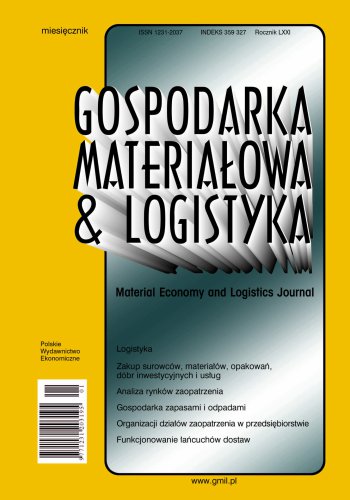Polish cross-border rail during the COVID-19 pandemic
Cross-border railroads are a fast way to move to another country. Trains are a means of transportation with relatively low border crossing formalities. Currently, Poland conducts cross-border passenger rail traffic with almost all of its neighbours: Germany, the Czech Republic, Slovakia, Ukraine and Lithuania. The worldwide pandemic of the SARS-CoV-2 virus has disrupted passenger transportation between countries. In Poland, it affected the schedules of trains running to neighbouring countries. The number of courses was reduced, and some routes were completely suspended. Cross-border traffic was also not unaffected by the war in Ukraine. The fundamental purpose of the article is to present an analysis of cross-border connections and to assess their quality, indicate the direction of change after the COVID-19 pandemic. The article examines the network of connections available at this point and discusses them in terms of transport accessibility. The results of the analysis will be used to compare rail connections with each other and, as a result, to identify certain relationships. The content presented will help to answer the question of whether cross-border rail after pandemic has undergone a significant transformation, and what is the direction of the observed changes. These considerations may inspire further research into the impact of the COVID-19 pandemic on the operation of cross-border rail crossings and connections between Poland and its neighbours.
References
Bibliografia/References
Literatura/Literature
Bajak, M. (2022). Smart logistics: Sustainable distribution in the age of the Internet of Things. W: J. Domagała, A. Górecka, M. Roman (Red.), Sustainable Logistics. How to Address and Overcome the Major Issues and Challenges (223–248). Taylor & Francis.
Beim, M., & Soczówka, A. (2016). Rozwój kolejowych, regionalnych połączeń transgenicznych w Polsce. Transport Miejski i Regionalny, (10), 19–24.
Budzowski, A. (2015). Problem międzynarodowych połączeń Krakowa w kontekście aktualnego Planu zrównoważonego rozwoju publicznego transportu zbiorowego. Transport Miejski i Regionalny, (1), 15–23.
Dębicki, M. (2019). Wyczytane z rozkładu jazdy. Transgraniczne połączenia kolejowe Polski – portret ilościowy i wstępne tropy interpretacyjne. UR Journal of Humanities and Social Sciences, 4(13), 112–130. https://doi.org/10.15584/johass.2019.4.7
Kolosov, V., & Więckowski, M. (2018). Border changes in Central and Eastern Europe: An introduction. Geographia Polonica, 91(1), 5–16. https://doi.org/10.7163/gpol.0106
Komornicki, T. (1999). Granice Polski. Analiza zmian przenikalności w latach 1990–1996. Geopolitical Studies. Instytut Geografii i Przestrzennego Zagospodarowania PAN.
Małysz, M. (2020). Nocne pociągi dalekobieżne w przestrzeni Polski – zarys historyczny i perspektywy rozwoju. Prace Geograficzne, (160), 53–73. https://doi.org/10.4467/20833113pg.20.003.12261
Pawłowski, K. (2021a). Uwarunkowania wykorzystywania transportu kolejowego w rozwoju turystyki międzynarodowej. W: K. Borodako (red.), Turystyka w okresie pandemii. Bogucki Wydawnictwo Naukowe. https://doi.org/10.12657/9788379863501-13
Pawłowski, K. (2021b). Zarządzanie pasażerskim transportem kolejowym w sytuacjach kryzysowych na przykładzie PKP Intercity w trakcie pandemii COVID-19. Gospodarka Materiałowa i Logistyka, (6), 36–44. https://doi.org/10.33226/1231-2037.2021.6.4
Pawłowski, K. (2022). Implikacje modernizacji połączeń kolejowych pomiędzy Krakowem i Katowicami na podstawie analizy rozkładu jazdy pociągów (13.12.2020–11.12.2021). Gospodarka Materiałowa i Logistyka, (4), 29–36. https://doi.org/10.33226/1231-2037.2022.4.4
Rogall, H. (2010). Ekonomika zrównoważonego rozwoju. Teoria i praktyka. Wydawnictwo Zysk i S-ka.
Sitarz, M., Bużałek, T., Pomykała, A., & Raczyński, J. (2019). Katowicki Węzeł Kolejowy – uwarunkowania historyczne i perspektywy rozwoju TEN-T. Technologia Transportu Szynowego, (11–12), 35–36.
Smolarski, M. (2018). Kolejowe przejścia graniczne na granicy polsko-czeskiej. Stopień wykorzystywania i oferta przewozowa. Przegląd Komunikacyjny, (3), 1–6.
Staszewska, J. (2009). Klaster perspektywą dla przedsiębiorstw na polskim rynku turystycznym. Diffin.
Taczanowski, J. (2012). A comparative study of local railway networks in Poland and the Czech Republic. W: D. Szymańska, J. Biegańska (Red.), Bulletin of Geography. Socio-economic Series, (18), 125–138. https://doi.org/10.2478/v10089-012-0025-1
Więckowski, M. (2010). Turystyka na obszarach przygranicznych Polski. Prace Geograficzne. Instytut Geografii i Przestrzennego Zagospodarowania PAN.
Wyszomirski, O. (2008). Ekonomika i organizacja. Wydawnictwo Uniwersytetu Gdańskiego.

